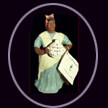Reflections of the South
|
Reflections of the South |
This essay companying the African American Tignon Law Doll, Marie Constance, is based on a true story. Read about Marie Constance and the plight of the New Orleans beautiful women of color who were ordered to wear a Tignon (bandanna) on their head in 1792. This law was an attempt to label these African American women.
"Marie-Constance"
1760-1843
written by Marie-Antoinette Langlais
Born a slave in 1760, Marie-Constance Gaillard saw many
changes in the treatment of her people, “people of color”, in New Orleans in
her more than 80 years. Under France’s rule by the Code Noir (Black Code) of
1724, free persons of color had the same rights of any French citizen of
Louisiana except for marriage with and legacies from whites. While free, they
weren’t quite equal and occupied a complicated and ambiguous place between
whites and slaves.
In the early days of the city,
with the shortage of white women, French men formed liaisons with their African
slaves. The children of these unions were recognized by their fathers, supported
and educated. The mothers and children were often given their freedom. The
consequence was a large population of free people of color in New Orleans, a
unique situation in America.
Marie-Constance and her five siblings were the result of such a union. Her
mother, Marion Dubreuil was the slave of the white cooper, Raymundo Gaillard.
In 1773, Raymundo freed Marion, his parda slave, and the children they had
together. Five years later, the couple and their children were still living
together on the left side of Usulines Street. The children and Marion received
property from Raymundo during his lifetime.
Unlike her mother,
Marie-Constance married a free man of color. On the 10th of May 1777, at the age
of 19, Marie-Constance married Charlot “Carlos” Brule in Saint Louis
Cathedral. The marriage contract made by the couple lists the assets
Marie-Constance brings to the marriage: 500 piastres in silver, clothes and
furniture valued at 360 piastres and a “negrita” slave named Leonor of about
13 years of age. Charlot and Marie-Constance would have fourteen children in
their 37 years of marriage.
Charlot Brule was a carpenter
and also an officer in New Orleans’ free pardo and moreno militia. This gave
him privileges and benefits not available to other free men of color. The family
was financially comfortable. During the fire of 1788, they lost property in the
amount of 2,850 pesos (an amount equal to the cost of rebuilding the French
Market) for which they petitioned the crown for compensation. The Brules owned
as many as 6 slaves.
In the 1805 New Orleans city
directory they are living on St. Philip Street between Dauphine and Burgundy.
Charlot Brule’s death record has not been found, but an inventory for his
estate in 1814 shows he died about that time. Along with personal property, the
inventory lists a house on Royal Street, the house on St. Philip and the one
adjacent to it, as well as two lots in Faubourg, in all valued at $8370 (an
amount equal to $106,500 today, although the property values would be
considerably higher now!). Marie-Constance remained in the St. Philip Street
house the rest of her life, listed in the city directories as “Madame Charlot
Brule”. The house was sold by her heirs, but it still stands at 910 St. Philip
St.
New Orleans
came under Spanish rule in 1763. In 1786, newly arrived Governor Don Estevan
Miro passed laws intending to tighten control over non-whites. Apparently the
beautiful, graceful free women of color and their relationships with white men
had become a threat to the white women of New Orleans. Among his edicts, the
Governor passed what became known as “The Tignon Law”, to put these women in
their proper place. (No mention was made of the white men who made their
lifestyle possible!) It forbade free women of color from appearing in public
wearing silks, plumes, and jewelry. Head coverings were restricted to the types
of kerchiefs--tignons- worn by slave women. The free women of color soon adapted
these coverings to elaborate, colorful turbans in defiance of Miro’s edict of
humble appearance for these women. Marie-Constance, legally married, no threat
to any white woman, nevertheless was bound by the law.
By the
1830’s the Americans were enforcing laws meant to curb the influence of New
Orleans’ free people of color. Americans saw free people of color as a danger
to the establishment of slavery (in spite of the fact that more free people of
color owned slaves than did white people!). New Orleans’ people of color were
forced to carry proof of freedom at all times. They could no longer testify
against whites in court and they were discriminated against by banks who were
afraid the people of color were numerous and wealthy enough to take them over.
For these people, many of whom had been free for generations and had never known
slavery, these policies were insulting.
With her
death on September 4, 1843, Marie-Constance Gaillard, Madame Charlot Brule,
lived just long enough to see her position come almost full circle.
Although born a slave, she lived most of her life as a free person, with a high
social position among persons of color. For her children, if they remained in
New Orleans, life would be very different.
JoAnn Bernard is a self-taught artist. Born JoAnn Gonzales on the bayou of Delacroix Island, Louisiana, with an Islenos heritage that stems back to Spain's Canary Islands. Her love of the beautiful State of Louisiana has inspired the Days of Old Collection, a line of Louisiana heritage character dolls. Through research, she has reproduced Louisiana ancestry; African American, Cajun, Islenos and others in life-like forms as they were seen years ago. JoAnn has created a complete original collection. She sculpts the original pieces and reproduces them in plaster molds. The face of each character is hand-painted, dressed (clothing and jewelry may vary) and positioned on handcrafted wooden pedestals and chairs to recreate photographs and sketches of the 1800's. The body designs are unique in construction and design. All wigs are hand-made by the artist using mohair strands. The artist developed original clothing designs and patterns. Props were designed and created for each individual character doll. All clay pieces are limited editions of 500 and are numbered and signed by the artist. Booklets and display cards are also designed by Jo Ann to include the number of the piece and a short story about the character doll. Booklets are attached to the piece, and the display card can be framed to stand along side the piece. Character dolls range in height from 16 to 18 inches tall. Total height of the piece may vary depending upon position of character dolls. A numbered and signed Certificate of Authenticity is provided with each character doll.
©Jo Ann Bernard
Attached booklets contain above information
Previous or Next Doll Story Page
Visit the Louisiana State Crafts Program
Learn about Louisiana Culture through this African American Heritage Doll collection inspired by sketches, photographs and stories of the 1800's.
Display card and Booklets printed on aged parchment paper
|
Menu Options |
|||||
|
Home Page |
 Louisiana Heritage Dolls |

Figurines, Sculptured Slates and Inspirational sketches |

Oil Paintings |

Duck Carving |
Doll Making Techniques/Bio
|
For more information email: jo_ann_bernard@southernelegance.net